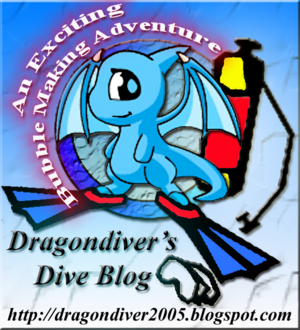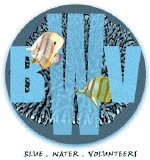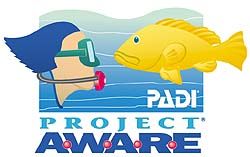Hantu Blog's 3rd Anniversary Dive Part TWO
25 March 2007
Dive No. 1 - Sexy Sea Slugs
Dive Site: Northern Jetty
Location: Pulau Hantu Kechil
Visibilty: 2 m
Temperature: 29°C
Maximum Depth: 12.5 m
Actual Bottom Time: 66 mins
Time in: 1050 hrs
The waters in this narrow channel on the nothern side of P. Hantu was seemingly calm from the surface. The nearby reclaimation works on Pulau Bukom transmitted amplified sound waves underwater. Luckily, the head throbbing vibrations ceased a few minutes after we descended.
I buddied Debby and Jimmy and we worked west really slowly towards the Northern Jetty. As with any other muck habitats, the critter encounters were overwhelming. The following are some of the fauna I managed to photograph on just a single dive and amazingly, they were found in the highly discriminated waters of Pulau Hantu!
 A Rosy Spindle Cowry (Phenacovolva rosea) that Jimmy pointed out to me on a gorgonian just under the jetty.
A Rosy Spindle Cowry (Phenacovolva rosea) that Jimmy pointed out to me on a gorgonian just under the jetty.
 I flipped over a large piece of brown rotting Mangrove Apple leaf with my rod and guess what was clinging to it on the underside? A large and well camouflaged Dorippid Crab (Dorippe sp.)! The Brachyuran Crab pictured above belonged to the subfamily Dorippinae, family Dorippidae MacLeay, 1838. It is adapted to carry bivalve shells, leaves, jellyfishes, anemones, urchins or other objects on their backs by using the hooked dactyli of their last two pairs of pereiopods, which are dorsally located and mobile. The rare find of this Dorippid Crab in shallow waters of about 8m and its large carapace length of about 10 cm, narrowed its genera to the Dorippinae subfamily. This specific subfamily of the Brachyuran is only found in the Indo-pacific region and in shallow waters. They are larger in size as compared to their other Dorippid (Ethusinae) cousins which inhibits deep waters (>1000m). This subfamily consists of the following clades: Dorippe, Medorippe, Dorippoides, Neodorippe, Heikea, Paradorippe and Philippidorippe. Little information is known about the affinities and distinctions between the clades. Judging from the length of its eye peduncles, pereiopods and the shape of its carapace, I would deduce it to be from the Dorippe species and it sure looks uncannily alike to Dorippe quadridens. It has numerous bristle-like hairs over its surface to enable it to trap silt and sand particles for camouflage. The puzzling feature of this crab though is its missing chelipeds(the frontal pair of clawed limbs).
I flipped over a large piece of brown rotting Mangrove Apple leaf with my rod and guess what was clinging to it on the underside? A large and well camouflaged Dorippid Crab (Dorippe sp.)! The Brachyuran Crab pictured above belonged to the subfamily Dorippinae, family Dorippidae MacLeay, 1838. It is adapted to carry bivalve shells, leaves, jellyfishes, anemones, urchins or other objects on their backs by using the hooked dactyli of their last two pairs of pereiopods, which are dorsally located and mobile. The rare find of this Dorippid Crab in shallow waters of about 8m and its large carapace length of about 10 cm, narrowed its genera to the Dorippinae subfamily. This specific subfamily of the Brachyuran is only found in the Indo-pacific region and in shallow waters. They are larger in size as compared to their other Dorippid (Ethusinae) cousins which inhibits deep waters (>1000m). This subfamily consists of the following clades: Dorippe, Medorippe, Dorippoides, Neodorippe, Heikea, Paradorippe and Philippidorippe. Little information is known about the affinities and distinctions between the clades. Judging from the length of its eye peduncles, pereiopods and the shape of its carapace, I would deduce it to be from the Dorippe species and it sure looks uncannily alike to Dorippe quadridens. It has numerous bristle-like hairs over its surface to enable it to trap silt and sand particles for camouflage. The puzzling feature of this crab though is its missing chelipeds(the frontal pair of clawed limbs).
 A vicious blood red Swimming Crab (Thalamita spinimana) holding out its pair of pincers, ready to strike!
A vicious blood red Swimming Crab (Thalamita spinimana) holding out its pair of pincers, ready to strike!
 After I lost Debby and Jimmy nearing the end of my dive, I was surprised to have had found at least 4 different individuals of the Orange-spotted Pipefish (Corythoichtys ocellatus) swim-wriggling around the sponge and algae covered pillars of the jetty.
After I lost Debby and Jimmy nearing the end of my dive, I was surprised to have had found at least 4 different individuals of the Orange-spotted Pipefish (Corythoichtys ocellatus) swim-wriggling around the sponge and algae covered pillars of the jetty.
 A Bristle-tail Filefish (Acreichtys tomentosum) hovering near discarded metal pipes now overgrown with hydroids, algae and sponges. This species can sometimes be easily confused with its Strapweed cousin. Look for the characteristic elongated white patch which extends behind the gills.
A Bristle-tail Filefish (Acreichtys tomentosum) hovering near discarded metal pipes now overgrown with hydroids, algae and sponges. This species can sometimes be easily confused with its Strapweed cousin. Look for the characteristic elongated white patch which extends behind the gills.
 Orange-edged Black Flatworm (Pseudobiceros hancockanus)
Orange-edged Black Flatworm (Pseudobiceros hancockanus)
 Unidentified Polyclad Flatworm... Need a little help on ID here..thanks
Unidentified Polyclad Flatworm... Need a little help on ID here..thanks
 Undescribed Flatworm (Pseudoceros sp.)
Undescribed Flatworm (Pseudoceros sp.)
 Gold Speckled Flatworm (Thysanozoan nigropapillosum)
Gold Speckled Flatworm (Thysanozoan nigropapillosum)

 Left: A cuttle fish egg sac was laid down in the mud waiting to be hatched.
Left: A cuttle fish egg sac was laid down in the mud waiting to be hatched.
Right: The Pustulose Phyllidiella (Phyllidiella Pustulosa) is a Nudibranch commonly found in Singapore's waters.

 Left: Managed to get the backside shot of the Reliable Chromodoris (Chromodoris fidelis) as it was wriggling into a muddy crevice.
Left: Managed to get the backside shot of the Reliable Chromodoris (Chromodoris fidelis) as it was wriggling into a muddy crevice.
Right: A Cake-icing Chromodoris (Chromodoris tumulifera) with its gills retracted into its branchial pockets.
 The beautiful Bullock's Hypselodoris (Hypselodoris bullockii) seems to thrive well in muck environment like the waters of Singapore.
The beautiful Bullock's Hypselodoris (Hypselodoris bullockii) seems to thrive well in muck environment like the waters of Singapore.
 Intricately patterned Painted Hypselodoris (Hypselodoris infucata) raced across the silty bottom in search of food sources.
Intricately patterned Painted Hypselodoris (Hypselodoris infucata) raced across the silty bottom in search of food sources.
 The Blue Dragon (Pteraeolidia ianthina) farm zooxanthellae in its cerata as a supplement to its basic diet of hydroids.
The Blue Dragon (Pteraeolidia ianthina) farm zooxanthellae in its cerata as a supplement to its basic diet of hydroids.
 The Red-lined Flabellina (Flabellina rubrolineata) stores stinging nematocysts in the tips of its cerata as a defense mechanism. It obtains the stinging cells from its dietary hydroids and discharge them when harrassed.
The Red-lined Flabellina (Flabellina rubrolineata) stores stinging nematocysts in the tips of its cerata as a defense mechanism. It obtains the stinging cells from its dietary hydroids and discharge them when harrassed.
 Sex in the Sea
Sex in the Sea
As functional simultaneous Hermaprodites, Ophisthobranchs maintain active male and female sex organs on every individual with reproductive pores generally postioned on the right side of their necks. The same species recognise each other by chemo-reception. Contact of body and rhinopores is made and there is a certain amount of courtship. They crawl around each other, lining up their genital openings. Copulation may continue for several hours or even days. Mating is performed by injecting sperm into one another simultaneously. Reciprocal receipt of sperm is through everted genital organs.
 Colour variations in Hypselodoris Bullockii is fairly common. They ranged from full purple forms, to pink, or even white specimens. Mating of the differnt colour forms are evidence of them being the same species as to what was previously debated in ID and anatomy.
Colour variations in Hypselodoris Bullockii is fairly common. They ranged from full purple forms, to pink, or even white specimens. Mating of the differnt colour forms are evidence of them being the same species as to what was previously debated in ID and anatomy.
Dive No. 1 - Sexy Sea Slugs
Dive Site: Northern Jetty
Location: Pulau Hantu Kechil
Visibilty: 2 m
Temperature: 29°C
Maximum Depth: 12.5 m
Actual Bottom Time: 66 mins
Time in: 1050 hrs
The waters in this narrow channel on the nothern side of P. Hantu was seemingly calm from the surface. The nearby reclaimation works on Pulau Bukom transmitted amplified sound waves underwater. Luckily, the head throbbing vibrations ceased a few minutes after we descended.
I buddied Debby and Jimmy and we worked west really slowly towards the Northern Jetty. As with any other muck habitats, the critter encounters were overwhelming. The following are some of the fauna I managed to photograph on just a single dive and amazingly, they were found in the highly discriminated waters of Pulau Hantu!
 A Rosy Spindle Cowry (Phenacovolva rosea) that Jimmy pointed out to me on a gorgonian just under the jetty.
A Rosy Spindle Cowry (Phenacovolva rosea) that Jimmy pointed out to me on a gorgonian just under the jetty. I flipped over a large piece of brown rotting Mangrove Apple leaf with my rod and guess what was clinging to it on the underside? A large and well camouflaged Dorippid Crab (Dorippe sp.)! The Brachyuran Crab pictured above belonged to the subfamily Dorippinae, family Dorippidae MacLeay, 1838. It is adapted to carry bivalve shells, leaves, jellyfishes, anemones, urchins or other objects on their backs by using the hooked dactyli of their last two pairs of pereiopods, which are dorsally located and mobile. The rare find of this Dorippid Crab in shallow waters of about 8m and its large carapace length of about 10 cm, narrowed its genera to the Dorippinae subfamily. This specific subfamily of the Brachyuran is only found in the Indo-pacific region and in shallow waters. They are larger in size as compared to their other Dorippid (Ethusinae) cousins which inhibits deep waters (>1000m). This subfamily consists of the following clades: Dorippe, Medorippe, Dorippoides, Neodorippe, Heikea, Paradorippe and Philippidorippe. Little information is known about the affinities and distinctions between the clades. Judging from the length of its eye peduncles, pereiopods and the shape of its carapace, I would deduce it to be from the Dorippe species and it sure looks uncannily alike to Dorippe quadridens. It has numerous bristle-like hairs over its surface to enable it to trap silt and sand particles for camouflage. The puzzling feature of this crab though is its missing chelipeds(the frontal pair of clawed limbs).
I flipped over a large piece of brown rotting Mangrove Apple leaf with my rod and guess what was clinging to it on the underside? A large and well camouflaged Dorippid Crab (Dorippe sp.)! The Brachyuran Crab pictured above belonged to the subfamily Dorippinae, family Dorippidae MacLeay, 1838. It is adapted to carry bivalve shells, leaves, jellyfishes, anemones, urchins or other objects on their backs by using the hooked dactyli of their last two pairs of pereiopods, which are dorsally located and mobile. The rare find of this Dorippid Crab in shallow waters of about 8m and its large carapace length of about 10 cm, narrowed its genera to the Dorippinae subfamily. This specific subfamily of the Brachyuran is only found in the Indo-pacific region and in shallow waters. They are larger in size as compared to their other Dorippid (Ethusinae) cousins which inhibits deep waters (>1000m). This subfamily consists of the following clades: Dorippe, Medorippe, Dorippoides, Neodorippe, Heikea, Paradorippe and Philippidorippe. Little information is known about the affinities and distinctions between the clades. Judging from the length of its eye peduncles, pereiopods and the shape of its carapace, I would deduce it to be from the Dorippe species and it sure looks uncannily alike to Dorippe quadridens. It has numerous bristle-like hairs over its surface to enable it to trap silt and sand particles for camouflage. The puzzling feature of this crab though is its missing chelipeds(the frontal pair of clawed limbs). A vicious blood red Swimming Crab (Thalamita spinimana) holding out its pair of pincers, ready to strike!
A vicious blood red Swimming Crab (Thalamita spinimana) holding out its pair of pincers, ready to strike! After I lost Debby and Jimmy nearing the end of my dive, I was surprised to have had found at least 4 different individuals of the Orange-spotted Pipefish (Corythoichtys ocellatus) swim-wriggling around the sponge and algae covered pillars of the jetty.
After I lost Debby and Jimmy nearing the end of my dive, I was surprised to have had found at least 4 different individuals of the Orange-spotted Pipefish (Corythoichtys ocellatus) swim-wriggling around the sponge and algae covered pillars of the jetty. A Bristle-tail Filefish (Acreichtys tomentosum) hovering near discarded metal pipes now overgrown with hydroids, algae and sponges. This species can sometimes be easily confused with its Strapweed cousin. Look for the characteristic elongated white patch which extends behind the gills.
A Bristle-tail Filefish (Acreichtys tomentosum) hovering near discarded metal pipes now overgrown with hydroids, algae and sponges. This species can sometimes be easily confused with its Strapweed cousin. Look for the characteristic elongated white patch which extends behind the gills. Orange-edged Black Flatworm (Pseudobiceros hancockanus)
Orange-edged Black Flatworm (Pseudobiceros hancockanus) Unidentified Polyclad Flatworm... Need a little help on ID here..thanks
Unidentified Polyclad Flatworm... Need a little help on ID here..thanks Undescribed Flatworm (Pseudoceros sp.)
Undescribed Flatworm (Pseudoceros sp.) Gold Speckled Flatworm (Thysanozoan nigropapillosum)
Gold Speckled Flatworm (Thysanozoan nigropapillosum)
 Left: A cuttle fish egg sac was laid down in the mud waiting to be hatched.
Left: A cuttle fish egg sac was laid down in the mud waiting to be hatched.Right: The Pustulose Phyllidiella (Phyllidiella Pustulosa) is a Nudibranch commonly found in Singapore's waters.

 Left: Managed to get the backside shot of the Reliable Chromodoris (Chromodoris fidelis) as it was wriggling into a muddy crevice.
Left: Managed to get the backside shot of the Reliable Chromodoris (Chromodoris fidelis) as it was wriggling into a muddy crevice.Right: A Cake-icing Chromodoris (Chromodoris tumulifera) with its gills retracted into its branchial pockets.
 The beautiful Bullock's Hypselodoris (Hypselodoris bullockii) seems to thrive well in muck environment like the waters of Singapore.
The beautiful Bullock's Hypselodoris (Hypselodoris bullockii) seems to thrive well in muck environment like the waters of Singapore. Intricately patterned Painted Hypselodoris (Hypselodoris infucata) raced across the silty bottom in search of food sources.
Intricately patterned Painted Hypselodoris (Hypselodoris infucata) raced across the silty bottom in search of food sources. The Blue Dragon (Pteraeolidia ianthina) farm zooxanthellae in its cerata as a supplement to its basic diet of hydroids.
The Blue Dragon (Pteraeolidia ianthina) farm zooxanthellae in its cerata as a supplement to its basic diet of hydroids. The Red-lined Flabellina (Flabellina rubrolineata) stores stinging nematocysts in the tips of its cerata as a defense mechanism. It obtains the stinging cells from its dietary hydroids and discharge them when harrassed.
The Red-lined Flabellina (Flabellina rubrolineata) stores stinging nematocysts in the tips of its cerata as a defense mechanism. It obtains the stinging cells from its dietary hydroids and discharge them when harrassed. Sex in the Sea
Sex in the SeaAs functional simultaneous Hermaprodites, Ophisthobranchs maintain active male and female sex organs on every individual with reproductive pores generally postioned on the right side of their necks. The same species recognise each other by chemo-reception. Contact of body and rhinopores is made and there is a certain amount of courtship. They crawl around each other, lining up their genital openings. Copulation may continue for several hours or even days. Mating is performed by injecting sperm into one another simultaneously. Reciprocal receipt of sperm is through everted genital organs.
A little sketch in my logbook
 Colour variations in Hypselodoris Bullockii is fairly common. They ranged from full purple forms, to pink, or even white specimens. Mating of the differnt colour forms are evidence of them being the same species as to what was previously debated in ID and anatomy.
Colour variations in Hypselodoris Bullockii is fairly common. They ranged from full purple forms, to pink, or even white specimens. Mating of the differnt colour forms are evidence of them being the same species as to what was previously debated in ID and anatomy.Labels: Dive Report




























0 Bubbles Created:
Post a Comment
<< Home